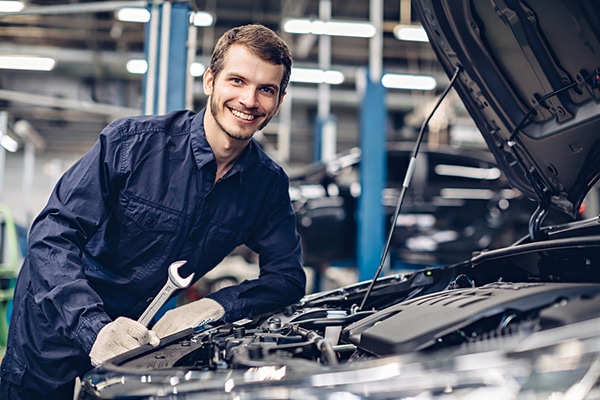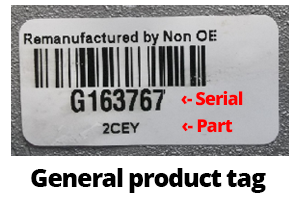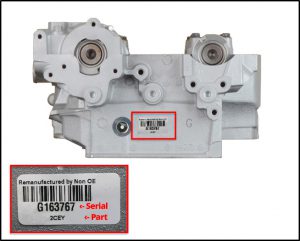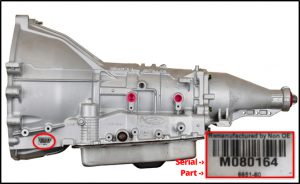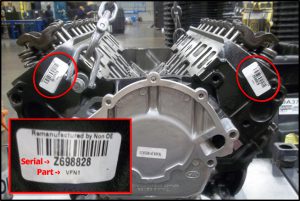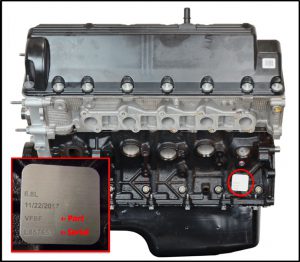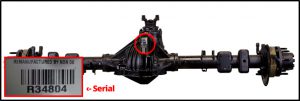The manufacturer strongly recommends that the following items be replaced when installing a remanufactured engine assembly:
- ENGINE OIL — follow the vehicle’s original specifications regarding type and viscosity — it’s important to use a non‐synthetic or non‐synthetic blend oil for the duration of the break‐in of your remanufactured engine
- FILTERS — oil, air & fuel
- IGNITION — spark plugs and plug wires, distributor cap, and rotor (where applicable)
- COOLING SYSTEM — a mixture of 50% antifreeze/coolant and water (follow the original manufacturer’s recommendation’s regarding antifreeze type), thermostat, radiator cap, and all hoses and belts
- PCV valve, grommets, and hoses
- Oil pump pick-up tube and drive rod or collar (if not included with engine)
We also suggest that the following items be cleaned, inspected, and replaced if necessary:
- Carburetor or fuel injection system
- Distributor
- Radiator (all radiators should be rod out, re-cored, or replaced)
- Water pump
- Intake and exhaust manifolds
- EGR valve
- Harmonic balancer
- Flex-plate or flywheel
- Valve covers and baffles, timing cover and oil pan (if not included with engine)
- All engine and transmission mounts
Any of these items which are faulty or improperly adjusted can lead to premature engine failure and may not be covered by your remanufactured engine warranty.
Tool checklist
There are a few special tools you will need to install this engine properly. Make sure you have them available before you start.
- Repair manual (for the vehicle you’re working on)
- Mechanical oil pressure gauge
- Torque wrench
- Engine oiler (optional)
Preparation before you start
These recommendations are intended as guidelines that should be followed during any engine installation. For more specific instructions about the vehicle you’re working on, you should refer to the repair manual.
- Take a moment to verify that this is the correct engine for your application.
- On engines supplied with valve covers, timing cover, and oil pan, please be aware that these parts may not fit all applications.
- Please clean and re-use any original parts.
- Turn the engine over by hand. This is easily done by installing the bolt that goes in front of the crankshaft and turning the engine with a wrench. The engine should turn smoothly.
- If it does not, STOP and call our Customer Care team for assistance.
Installation
Some of the most common causes of premature engine failure are:
- Detonation and pre-ignition
- Overheating
- Lack of proper lubrication
- Contaminations from reinstallation of dirty parts
Protect yourself from these common problems by paying extra attention to the vehicle’s cooling, ignition, fuel, exhaust, and emission systems.
Clean and inspect
- Avoid bearing and piston damage by carefully cleaning the oil pan, timing cover, and valve covers.
- A frequent trouble spot on V6 and V8 engines is the underside of the intake manifold. In many cases, there is a sheet metal shield under the manifold. It should be removed, cleaned, and reinstalled.
- In some instances, this shield is riveted to the manifold.
- If you are not able to remove and reinstall the shield, take it to your local automotive machine shop to have it cleaned.
- Remove and clean under valve cover baffles. Sludge build up under the valve cover baffle will prevent vapor and oil separation resulting in oil consumption.
- Always use a new oil pump pickup tube. Remember that sludge or hard carbon deposits left on these parts can damage bearings and clog valve lifters.
Never use sand-blasted, bead-blasted parts, or surface conditioning discs. Debris from these will cause damage to bearings, piston rings, and cylinder walls.
The manufacturer strongly recommends that you do not use sand-blasted, bead blasting or service conditioning discs. The use of these cleaning methods will result in damage to the engine that is not covered by the warranty.
Mating the engine and transmission
Never use excessive force while mating the transmission to the engine. These parts should come together easily. The need to use force indicates a problem. In these cases, you should refer to the repair manual or call our Customer Care department for help.
Carefully inspect the flex-plate and flywheel for cracks and other damage.
- Flex-plates require special attention to the area that bolts to the crankshaft. This is where most cracks begin.
- Damaged flywheels will show signs of bluing and/or small cracks on the friction surface. Flywheels showing signs of this damage should be resurfaced or replaced.
- As a final check to both flex-plates and flywheels, always be sure the ring gear teeth are in good condition and show no signs of wear.
- Never use an impact gun to tighten the flywheel bolts. Doing so can distort the rear main seal journal surface.
- Many domestic and foreign engines require thread sealant on the flywheel bolts. Failure to apply sealant will result in oil leaks.
Refer to your repair manual or call our Customer Care department for help.
Before you start the engine
The initial start-up of any remanufactured engine is critical. Performed correctly, it will ensure long engine life. However, make a mistake here, and it can result in immediate engine failure.
Cooling system
- Completely fill the cooling system. In most cases, this is made easier by removing the thermostat.
- Be careful on vehicles where the engine sits higher than the radiator because pockets of air can become trapped and create hot spots that can cause engine damage. Make sure you get all of the air out of the cooling system and engine before you start the vehicle.
- Prevent overheating damage by replacing all belts and hoses.
- Always use a new thermostat and radiator cap.
- Send the radiator out to be inspected — rod out, re-core, or replace if necessary.
- Check your water pump carefully. The pump shaft should have no side-to-side play and should spin smoothly. It should show no signs of leakage. If it does, replace the water pump.
- On cars so equipped, make sure the thermostatic fan clutch or electric fan and fan switch are working properly.
- Bleed the cooling system of air. Always use fresh coolant in a 50/50 mix with water or follow the original manufacturer’s recommended antifreeze type and mixture.
For specific instructions, refer to the repair manual.
Ignition system
- Check the ignition distributor shaft and gear for any excessive wear.
- Make sure the advance mechanisms (mechanical and vacuum) are working properly.
- Replace the distributor cap, rotor, plug wires, and spark plugs (use the correct heat range).
- Check and set ignition timing (initial) to the manufacturer’s specifications and then CHECK FOR TOTAL IGNITION ADVANCE (refer to the shop manual for that exact procedure). Remember that ignition timing too far advanced or retarded can cause detonation and pre-ignition.
- Double check your ignition wiring and firing order.
- If possible, static time the engine. This will help it start easier.
Fuel system
- Double check all fuel connections. Be extra careful on fuel-injected cars which have much higher fuel pressure.
- Double check all vacuum routing and connections.
- Make sure your fuel system (carburetor or fuel injection) is delivering the proper amount of fuel to the engine.
- Pay special attention to the automatic choke or cold start valve (on fuel-injected vehicles).
- Keep in mind that rich fuel mixtures can cause premature wear or damage to the pistons, piston rings, and cylinder walls. Lean fuel mixture is one of the primary causes of detonation and pre-ignition.
- If the vehicle sits for 30 days or more, drain and flush the fuel system.
- When in doubt, refer to the repair manual or the vacuum routing sticker in the vehicle’s engine compartment.
Emission and exhaust systems
- Make sure that all emission equipment is installed and working properly, especially the EGR valve. In many cases, the failure (or in-operations) of the EGR valve alone can cause severe engine damage as a result of detonation or pre-ignition. If you are not familiar with all the emission equipment on the vehicle, refer to the repair manual.
- Poor engine performance and high operating temperatures can indicate other obstructions in your exhaust system. To check for a clogged catalytic converter or other parts of the exhaust system, refer to the repair manual.
We urge you to drive responsibly and obey all traffic laws. Some applications may not meet emission standards. Check with local and state ordinances before purchasing your engine to ensure legality.
Lubrication system
The engine should be properly “pre-lubed.” This means supplying pressurized oil to all the bearing and wear surfaces in the engine before it is started.
- On engines where the ignition distributor drives the oil pump, this can be done by removing the distributor and turning the oil pump with a drill motor until oil appears at the rocker arms.
- A much better method, especially on engines without distributor-driven oil pumps, is to use an optional oiler. This device enables you to supply pressurized oil to the entire engine without removing the distributor. It also enables you to properly pre-lube engines with non-distributor-driven oil pumps.
- A mechanical oil pressure gauge should be installed so that you can monitor oil pressure during start-up.
At start-up
- Verify you have oil pressure (at least 10 psi) and immediately raise the engine speed to 2,000 RPM and hold it there for 15-20 minutes. If the engine fails to start, quickly check your fuel and ignition systems again.
- Do not crank the engine excessively as this can cause damage to the bearings.
- During this 20-minute period, adjust the ignition and fuel systems to the manufacturer’s specifications.
After initial start-up
- Let the engine cool down (at least three hours).
- As part of the installation process, we recommend readjustment of the valve lash for engines that utilize an adjustable valve train.
- For shim-type adjustable valve trains, we recommend verifying lash is within manufacturer’s specification.
- We also recommend re-torque of the intake and exhaust manifolds to the manufacturer’s specifications at this time.
- Check the tension of the belts that drive the accessories, they will stretch after the initial start-up and can become loose. A properly tensioned belt will deflect ½” when checked midway between the accessory and crankshaft pulley.
- A loose water pump belt can cause the engine to overheat.
- Over tightened belts can cause premature failure of accessories like alternators and power steering pumps.
WARNING: During start-up of a remanufactured engine, oil pressure an engine temperature are critical. Carefully monitor both of these functions at all times. Do not start the engine and wait for oil pressure to rise. Never allow the engine to overheat.
Failure to follow these instructions will void any warranty.
Additional checks
In many applications, the engine’s oil pump is driven by the ignition distributor.
- Make sure the oil pump’s drive, whether it’s a shaft or collar, is fully engaged in both the pump and the distributor. Failure to do this can cause a loss of oil pressure and will damage bearings.
- Prevent damage to the crankshaft and thrust bearing by checking the end-play of your old engine. Excessive end-play can indicate a problem with the vehicle’s transmission or torque converter.
On vehicles with STANDARD TRANSMISSIONS:
- Always replace the pilot bearing or bushing.
- Make sure the transmission input shaft is clean and in good condition.
- Make sure the clutch linkage (either mechanical or hydraulic) has the proper amount of free-play. Insufficient clearance can cause thrust bearing damage.
On vehicles with AUTOMATIC TRANSMISSIONS:
- Inspect the torque converter carefully. A worn or damaged converter can exert pressure on the rear of the crankshaft, causing damage to the crankshaft and thrust bearing. Refer to the shop manual or a transmission repair facility for specific checks.
- Make sure the front hub of the converter and the rear of the crankshaft are clean.
- Make sure the torque convertor is installed properly. Improper installation can cause thrust bearing damage. Refer to your repair manual for installation instructions.
Detonation and pre-ignition have become the most common causes of premature engine failure. This condition is often referred to as “pinging” or “knocking” and causes dramatic increases in the temperature and pressure inside the combustion chamber. This will result in severe engine damage.
To prevent piston, ring, and head gasket damage association with detonation and pre-ignition, be certain that the vehicle’s fuel, ignition, exhaust, and emission systems are in perfect working order.
Engines that have failed due to detonation and/or pre-ignition will not be warranted by the manufacturer.

